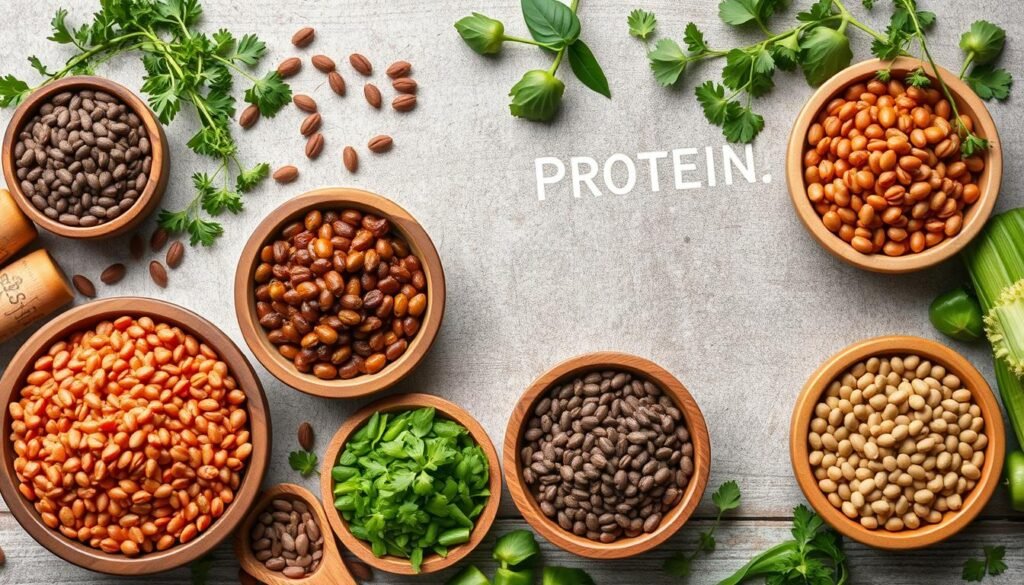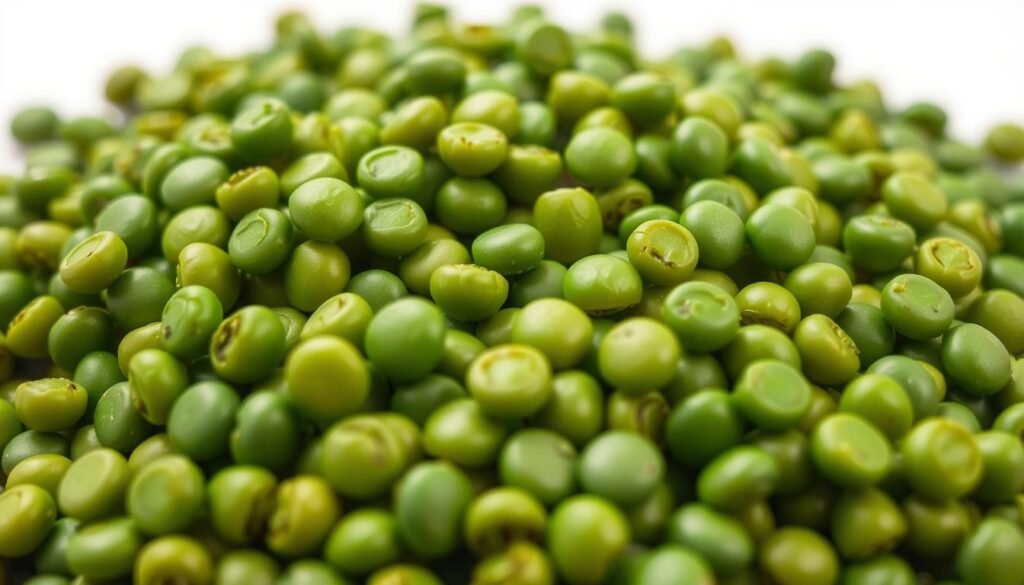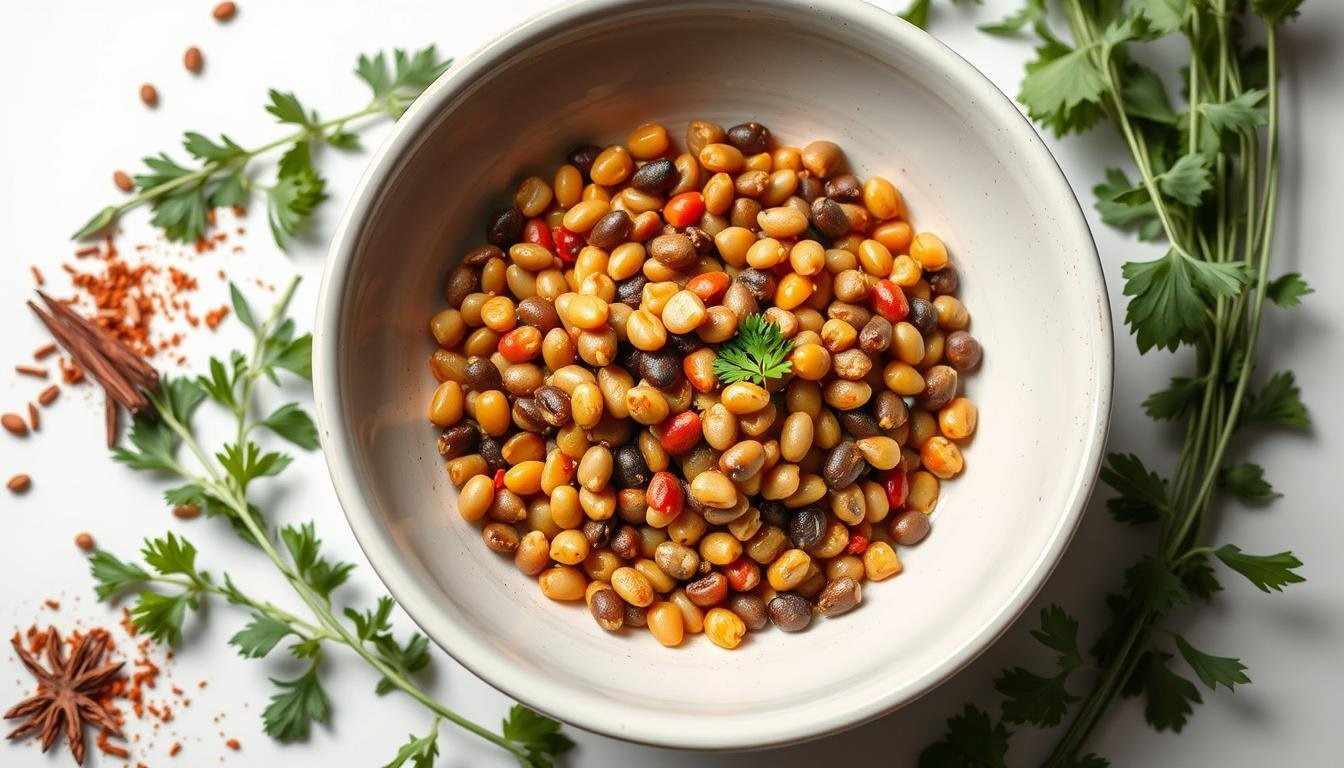Did you know lentils, a simple legume, are a protein powerhouse? In fact1, they have over 25% protein, making them a top choice for plant-based nutrition. They are perfect for vegetarians, vegans, and anyone wanting more non-animal protein.
I’ve started eating more lentils, and it’s made a big difference. Just1 1 cup (198 grams) of cooked lentils gives you 230 calories, 39.9 grams of carbs, 17.9 grams of protein, 0.8 grams of fat, and 15.6 grams of fiber. That’s a lot of good stuff!
Key Takeaways
- Lentils are an excellent source of plant-based protein, containing over 25% protein.
- Just 1 cup of cooked lentils provides a wealth of essential nutrients, including fiber, carbs, and healthy fats.
- Lentils are a versatile and affordable way to add more plant-based protein to your diet.
- Lentils contain beneficial plant compounds like polyphenols that offer antioxidant and anti-inflammatory benefits.
- Incorporating lentils into your meals can support heart health, weight management, and overall well-being.
Introduction to Lentils
Lentils are a special part of the legume family, known for their unique shape and many uses in cooking2. They are a key food in many cultures, with Canada leading in their production2.
What are Lentils?
Lentils are edible seeds from the legume family. They can be found with or without their outer husks. They come in various colors like brown, green, yellow, red, and black2. People love them for their health benefits and their ability to fit into many different cuisines.
Types of Lentils
The main types of lentils are brown, green, and red. Each has its own taste and cooking time2. Brown lentils are the most common, ranging from khaki brown to dark black2. Green lentils taste more robust and peppery than brown ones2.
Red and yellow lentils are favorites in Indian and Middle Eastern cooking. They break down when cooked2. Black beluga lentils are small and have a deep, earthy flavor2. Puy lentils are dark green and have a strong, peppery taste2.
Lentils are nutritious and can be used in many dishes. They’re great in soups, stews, curries, and salads.

Nutritional Profile of Lentils
Lentils are packed with vitamins, minerals, and macronutrients. They stand out for their high protein content. Just ½ cup of cooked lentils gives you about 12 grams of plant-based protein3. This makes them a great choice for those who want to eat less meat.
Lentils are also rich in dietary fiber. A 1/2 cup of cooked green lentils meets 32% of your daily fiber needs3. This fiber is good for your digestive health and can help lower cholesterol.
Lentils are known for their micronutrient content. A 1/2 cup of cooked split red lentils has 273 mg of potassium3. Potassium is key for healthy blood pressure. Lentils also give you 15% of your daily iron in just 1/2 cup3. This is great for those eating a plant-based diet.
Lentils have a lot of folate. In fact, they have the most folate of all plant-based foods3. Folate is important for cell growth and development. It’s especially good for pregnant women or those trying to get pregnant.
Lentils also have a lot of manganese. Manganese helps keep blood sugar levels normal3. This shows how versatile lentils are as a nutritious part of a balanced diet.

“Lentils are a very good source of manganese, playing a role in maintaining normal blood sugar levels.”3
Health Benefits of Lentils
Lentils are a nutritious food that offers many health benefits. They are rich in lentils polyphenols4. These compounds have antioxidant and anti-inflammatory effects. They may help prevent heart disease and some cancers4.
Rich in Polyphenols
Lentils have been studied for their polyphenols. They show strong antioxidant activities in 11 varieties grown in the Northern United States4. They also have iron-enhancing properties4.
The phytochemical profile of lentils includes phytosterols, squalene, tocopherols, and fatty acids. This has been well-studied4. Lentils are also prebiotic-rich, which adds to their health benefits4.
The starch and fiber in lentils affect their digestibility and fermentability. Their chemical composition, dietary fiber, and resistant starch have been compared to other legumes4.
Lentil seeds have been studied for their mitogenic properties for B lymphocytes in mice. They have also been researched for their lectins in cancer treatment4. A novel defensin from lentil seeds has been identified, showing more beneficial compounds4.
The saponins in lentils may have anti-diabetic properties4. The seed coat’s proanthocyanidins enhance their antioxidant capabilities4.
In summary, lentils’ antioxidants and anti-inflammatory properties make them a nutritional powerhouse. They can greatly benefit overall health and wellbeing4.

Heart Health Benefits of Lentils
Lentils are a superfood for heart health. They are full of fiber, folate, and potassium5. These nutrients can help lower heart disease risk factors.
Studies show lentils can improve cholesterol, blood pressure, and homocysteine levels5. This is good for preventing heart attacks and strokes.
Lentils also help with weight management5. Animal studies found they lower blood pressure, cholesterol, and glucose levels5. Human studies show they improve cholesterol in diabetics and may fight breast cancer in women5.
Lentils are a superfood for heart health. Adding them to your diet can support a healthy heart5.
| Nutrient | Amount per Cup |
|---|---|
| Calories | 2306 |
| Protein | 18 grams6 |
| Fat | 1 gram6 |
| Carbohydrates | 40 grams6 |
| Fiber | 16 grams6 |
| Iron | 37% of daily intake6 |
| Sodium | 4 milligrams6 |
| Sugar | 4 grams6 |
Lentils are a powerhouse for heart health. They improve cholesterol and blood pressure. They also lower heart disease risk. Adding lentils to your diet is a delicious way to support heart health576.
Are lentejas good protein?
Yes, lentils are a great source of plant-based protein. They have about 18 grams of protein per cooked cup8. Their protein is of high quality, with all essential amino acids. However, they have less methionine and cysteine than animal proteins8.
When you pair lentils with brown rice, you get a complete protein. This makes them a perfect choice for a vegetarian or vegan diet8.
Lentils are also packed with other nutrients. One cup of cooked lentils has 200 to 250 calories and almost no fat8. They have 40 grams of carbs, 16 grams of fiber, and 18 grams of protein. Plus, they have no cholesterol8.
They also provide 20 percent of your daily vitamin B6 and 17 percent of magnesium8. Lentils also have about five percent of daily calcium and vitamin C needs8.
Lentils have more polyphenols than green peas and chickpeas. These compounds help with heart health and diabetes prevention8. With their high protein and nutrient content, lentils are a top choice for plant-based protein8.
| Lentil Variety | Protein (g) | Calories | Fiber (g) | Potassium (mg) | Calcium (mg) | Iron (mg) |
|---|---|---|---|---|---|---|
| Red Lentils | 129 | 1909 | 99 | 5009 | 119 | 39 |
| Brown Lentils | 119 | 1809 | 99 | 5509 | 239 | 39 |
| Petite French Green Lentils | 109 | N/A | 149 | 4379 | 239 | 49 |
Different lentil varieties have different amounts of protein, calories, and nutrients9. Protein is key for muscles, bones, and skin. It helps with repair and oxygen transport9.
Lentils are a great addition to a balanced diet. They offer high-quality protein and many nutrients.
“Lentils are a nutritional powerhouse, providing high-quality plant-based protein, fiber, and a host of essential vitamins and minerals. They are a versatile and affordable option for those looking to incorporate more legumes into their diet.”
Antinutrients in Lentils
Lentils, like other legumes, have trypsin inhibitors, lectins, tannins, and phytic acid10. These can block nutrient absorption. But, soaking and cooking lentils can lower these antinutrients10.
Trypsin Inhibitors
Trypsin inhibitors can slow down protein digestion10. But, processing methods can cut down their activity by 66-82% in lentil products10.
Lectins
Lectins are proteins in legumes, making up to 10% of total protein11. Some lectins are good for health, but others, like phytohemagglutinin in raw kidney beans, can be harmful. It’s best to cook legumes well11.
Tannins
Tannins can bind to proteins, making them less available. But, lentils have less tannins than other legumes10.
Phytic Acid
Phytic acid can block mineral absorption like iron, zinc, and calcium11. Yet, lentils’ nutritional benefits usually outweigh the drawbacks for most people10.
In short, lentils have some antinutrients, but cooking them right can lessen these effects. This makes lentils a nutritious and healthy food choice10.
Cooking Lentils
Lentils are a versatile and nutritious legume that can be added to many dishes. They are easy to prepare, unlike some other legumes that need soaking. To cook them, rinse, put in a pot with water or broth, and simmer for 20-30 minutes until tender12.
For quicker cooking, choose red or yellow split lentils. They become tender in just 5-10 minutes13. Canned lentils are also handy, making it easy to add them to your meals. Cooking them right reduces antinutrient compounds, making nutrients easier for your body to use12.
| Lentil Variety | Cooking Time |
|---|---|
| French green or black lentils | 20 minutes |
| Red lentils | 15 minutes |
Lentils are a great source of plant-based protein, with nearly 18 grams per cup12. They also have nearly 16 grams of fiber per cup, which aids digestion and keeps you full13. Plus, they have more iron than beef, with nearly 7 milligrams per cup12.
If you want more plant-based protein or just want to try lentils, learning how to cook them is a good start. With their quick cooking, rich nutrients, and versatility, lentils are a great choice for healthy meals1213.
Lentils as a Meat Substitute
Lentils are a great choice for a healthy and green meat substitute. Lentils as a meat alternative are packed with protein, making them a top plant-based protein source1. They have over 25% protein, making them a perfect meat substitute1.
Lentils are not just high in protein. They also have lots of essential nutrients like thiamine, niacin, and vitamin B61. They also have iron, magnesium, and zinc, and are full of health-promoting polyphenols1.
When paired with a whole grain, lentils become a complete protein source. This makes them a great meat substitute in many dishes1. You can use lentils in soups, stews, burgers, and tacos for a nutritious meal1.
| Nutrient | Amount per 1/2 Cup (100g) of Cooked Lentils |
|---|---|
| Calories | 14014 |
| Protein | 12g14 |
| Carbohydrates | 23g14 |
| Fiber | 9g14 |
| Sodium | 5mg14 |
| Potassium | 270mg14 |
| Iron | 15% of daily recommended intake14 |
Lentils are not only good for you, but they’re also super versatile. They can cook in just 5-30 minutes, and stay fresh for up to 5 days1. With their meaty texture and nutritional benefits, lentils are a great vegetarian protein source and plant-based protein option1.
“Lentils are an excellent source of complete proteins that can effectively replace meat in a variety of dishes.”
Potential Downsides of Lentils
Lentils are nutritious but have some downsides to consider1. They can cause allergies, especially in Europe where they’re used for babies. People allergic to chickpeas or peas might also react to lentils7. Some might feel bloated or gassy because lentils are high in fiber and have compounds that block nutrient absorption7.
To avoid these issues, it’s important to cook lentils right1. Cooking and soaking them can reduce harmful compounds7. Eating lentils in small amounts can also help those with sensitive stomachs avoid discomfort7.
Despite these challenges, lentils are still a great food choice1. They’re full of protein, fiber, and vitamins and minerals. Knowing how to handle their downsides lets people enjoy their health benefits. Check out different lentil products to add them to your meals.
| Potential Downside | Explanation |
|---|---|
| Allergies | Lentils are a common allergen, particularly in parts of Europe where they are often used as a weaning food. Those with allergies to other legumes like chickpeas or peas may be more prone to lentil allergies7. |
| Digestive Issues | Lentils are high in fiber and contain antinutrients like trypsin inhibitors and phytic acid that can hinder nutrient absorption, leading to gas, bloating, and other digestive problems for some individuals7. |
| Antinutrients | Lentils contain antinutrients such as trypsin inhibitors, lectins, tannins, and phytic acid, which can impair nutrient absorption if not properly prepared1. |
Knowing how to handle lentils’ downsides lets people enjoy their health benefits1. Cooking them right, eating them in moderation, and being aware of personal sensitivities can help. This way, lentils can easily fit into a healthy diet.
Conclusion
Lentils are a great source of plant-based protein, fiber, and important vitamins and minerals. They offer many health benefits, like helping your heart and controlling blood sugar15. Even though lentils have some antinutrients, cooking them right and eating them in moderation is key to enjoying their benefits16.
If you want to boost your protein intake, try new plant-based meals, or just eat something healthy and filling, lentils are a top pick16. They’re packed with plant-based protein, fiber, and nutrients, making them a great addition to any diet16.
Adding lentils to your meals lets you enjoy their many benefits and discover how versatile they are. They can be the main attraction or a key ingredient in many tasty, healthy dishes.
FAQ
Are lentils a good source of protein?
Yes, lentils are a top choice for plant-based protein. One cup of cooked lentils has about 18 grams of protein. They’re great for those who don’t eat meat or want more plant-based protein.
What are the different types of lentils?
Lentils come in many colors like brown, green, yellow, red, and black. The most common are brown, green, and red. Each type has its own taste and cooking time.
What are the key nutrients in lentils?
Lentils are full of vitamins, minerals, and macronutrients. They have high-quality plant-based protein, complex carbs, fiber, folate, iron, phosphorus, and potassium.
How do the polyphenols in lentils benefit health?
Lentils are rich in polyphenols, which are antioxidants and anti-inflammatory agents. These compounds may protect against heart disease and some cancers.
How do lentils support heart health?
Eating lentils can lower heart disease risk. Their fiber, folate, and potassium help with cholesterol, blood pressure, and homocysteine levels.
Do lentils provide complete proteins?
Lentils have all essential amino acids, but less methionine and cysteine than animal proteins. Pairing them with brown rice makes their protein complete and high-quality, perfect for a meat-free diet.
What are the antinutrients in lentils?
Lentils have antinutrients like trypsin inhibitors, lectins, tannins, and phytic acid. These can block nutrient absorption. But soaking and cooking greatly reduce these compounds.
How do you cook lentils?
Lentils are easy to cook without soaking. Rinse them, add to a pot with water or broth, and simmer for 20-30 minutes. Red or yellow split lentils cook in 5-10 minutes.
Can lentils be used as a meat substitute?
Yes, lentils are a great meat substitute due to their high protein and meaty texture. They’re perfect for vegetarians, vegans, and those cutting down on animal products. Pairing them with a whole grain makes their protein complete.
Are there any potential downsides to eating lentils?
While lentils are healthy, they can cause digestive issues like gas and bloating in some. They’re also a common allergen, especially in Europe. Proper preparation and moderation can help avoid these issues.
Source Links
- https://www.healthline.com/nutrition/lentils – Lentils: Nutrition, Benefits, and How to Cook Them
- https://www.fao.org/pulses-2016/blog/everything-you-need-to-know-about-lentils/en/ – Everything You Need to Know About Lentils | 2016 International Year of Pulses
- https://www.lentils.org/health-nutrition/nutritional-information/ – Nutritional Information
- https://www.ncbi.nlm.nih.gov/pmc/articles/PMC5713359/ – Polyphenol-Rich Lentils and Their Health Promoting Effects
- https://nutritionsource.hsph.harvard.edu/food-features/lentils/ – Lentils
- https://www.webmd.com/diet/health-benefits-lentils – Health Benefits of Lentils
- https://www.medicinenet.com/why_are_lentils_bad_for_you/article.htm – Why Are Lentils Bad for You? Nutritional Benefits of Legumes
- https://www.wellandgood.com/are-lentils-good-for-you/ – Are Lentils Good for You? Here Are 10 Reasons Why the Answer is ‘Yes’
- https://www.bobsredmill.com/blog/healthy-living/ahow-much-protein-is-in-one-serving-of-lentils/ – How Much Protein Is in One Serving of Lentils?
- https://www.ncbi.nlm.nih.gov/pmc/articles/PMC8039371/ – Nutritional and anti-nutritional properties of lentil (Lens culinaris) protein isolates prepared by pilot-scale processing
- https://www.healthline.com/nutrition/legumes-good-or-bad – Legumes: Good or Bad?
- https://www.prevention.com/food-nutrition/a39862096/what-are-lentils-how-to-cook/ – Are Lentils Really That Healthy? Experts Explain
- https://www.loveandlemons.com/how-to-cook-lentils/ – How to Cook Lentils – Love and Lemons
- https://health.clevelandclinic.org/health-benefits-of-lentils – The Health Benefits of Lentils
- https://www.news-medical.net/news/20240204/Lentils-lower-cholesterol-and-sugar-response-study-finds.aspx – Lentils lower cholesterol and sugar response, study finds
- https://theplantbasedschool.com/best-lentil-recipes/ – 20+ Lentil Recipes (easy meals) – The Plant Based School

